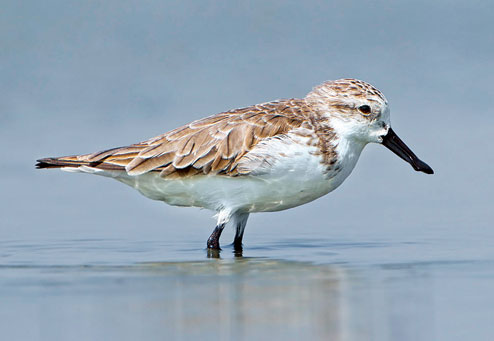 |
| The Spoon-billed Sandpiper |
A lookout notice has been served in the east for one of the world’s most wanted characters from the avian kingdom: the Spoon-billed Sandpiper.
A few of the less than 200 surviving pairs of this critically endangered species were last spotted along the Bangladesh coast in November, triggering anticipation of a chance appearance by the small flock in eastern India this winter.
That’s a large area to scout for a tiny population and the message from conservationists to birders in Bengal and elsewhere is: “Keep your eyes (and binoculars) open, please!”
Bengal and Odisha apart, the Bombay Natural History Society (BNHS) has alerted Andhra Pradesh and Tamil Nadu to the possibility of a rare sighting.
“We need to know about the winter habitats of this bird. It will help us to create awareness among people in these places and also engage local governments in conservation efforts. We need to save the species from extinction,” Raju Kasambe, project manager for the Important Bird Areas Programme at the BNHS, told Metro.
Scientists have long been tracking this elegant wader born with a spoon in its mouth but there’s still much left to know about its exact wintering habitats and stopovers during the migration flight from arctic Russia.
“The Spoon-billed Sandpiper population has declined by almost 90 per cent in the past 30 years. The last world congress of the International Union for Conservation of Nature in (South) Korea in 2012 listed this bird among the 100 most endangered species in the world,” Evgeny Syroyechkovsky, chairperson of the global Spoon-billed Sandpiper Task Force, said over phone from Russia.
The task force was constituted in 2010 and is supported by several organisations, including BirdLife International.
The species breeds in the northeast Russian peninsula and flies to southeast Asia during winter. It stops or flies via China, Japan and the two Koreas to spend the winter months in Myanmar, Bangladesh, Thailand, Vietnam and India.
The two primary reasons for the rapid decline of the Spoon-billed Sandpiper are common to almost all endangered species: hunting and habitat destruction.
In the Spoon-billed Sandpiper’s case, a very low rate of reproduction poses another potent threat to its existence.
“The reclamation of the intertidal mudflats in China for construction is destroying their habitat. Besides, people in Myanmar and Bangladesh kill the birds for meat and livelihood. We have started a project to create some alternative employment for the poor people so that they stop killing the birds,” Syroyechkovsky said.
The Indian birding community did much the same this year to save Amur Falcons from being hunted down during their annual visit to Wokha in Nagaland. A campaign to engage the administration and Naga villagers who had been killing the roosting falcons for their meat paid rich dividends.
The Spoon-billed Sandpiper apparently has even stronger enemies. “The worrying factor is the killing of birds in southern China for rich people to eat at restaurants,” Syroyechkovsky said.
There are only two records of the bird in India over the last two decades. One was seen at Chilika Lake in Odisha and another at Point Calimere Bird Sanctuary in Tamil Nadu.
A bird was also spotted in the Sunderbans around the same time but it’s a record that has been disputed.
BNHS, the Indian partner of BirdLife International, has sent Mumbai birder Parag Damle on a mission to find the bird. Damle has already started his coastal expedition and is currently scouting Tamil Nadu. He will move northwards along the Andhra and Odisha coasts before reaching Bengal.
“The search is on. Let’s keep our fingers crossed with the hope of some good news,” birding veteran Sumit Sen said.
Much will depend on the efforts of local birders and people living along the coast with some awareness of the Spoon-billed Sandpiper’s features.
Spotting is difficult from far because a single bird might be in a flock of 1,000 others of a different species.
Since awareness about its plumage is crucial — adults change plumage twice a year — BNHS is providing a detailed brochure on how to identify the bird to anyone who is interested.










